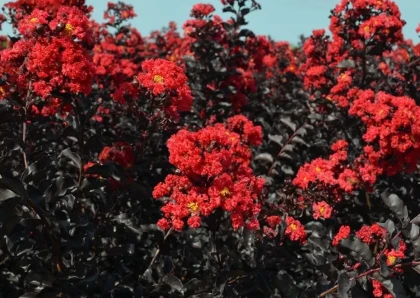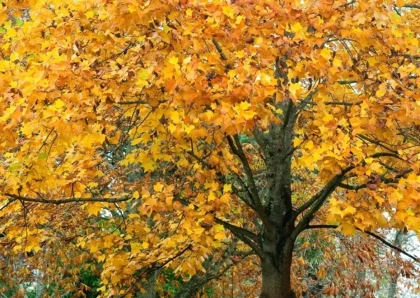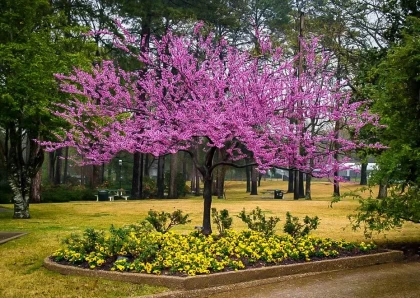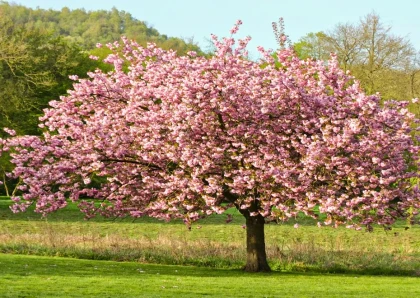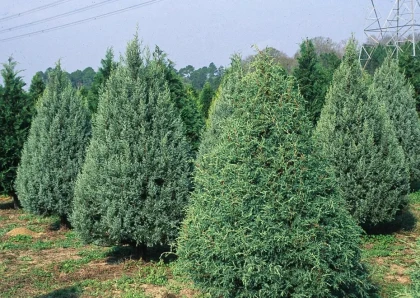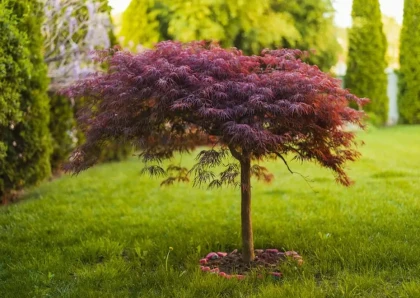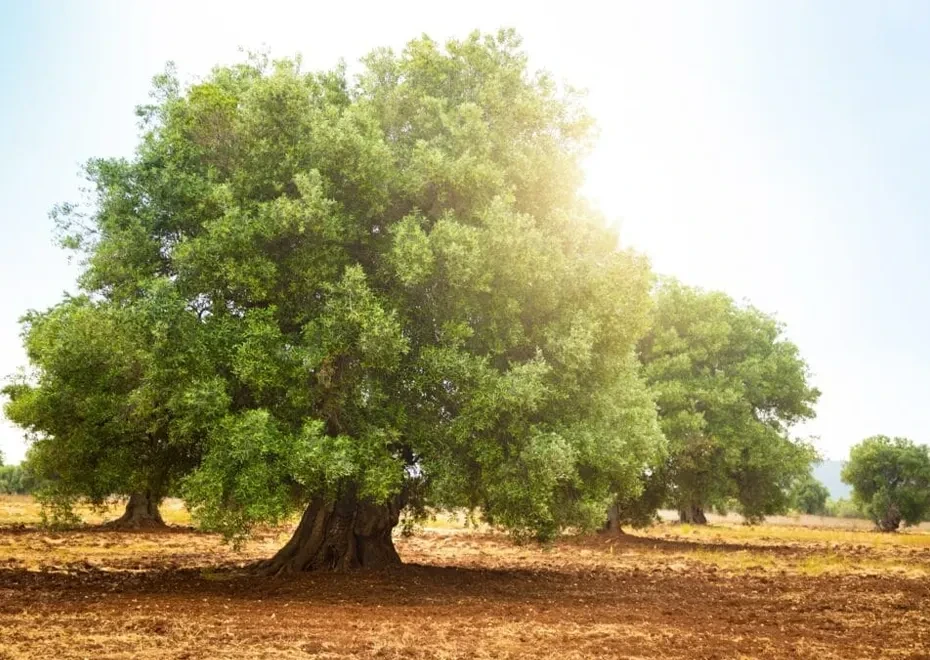
Arbequina Olive
Overview
History of the Tree
The Arbequina Olive Tree (Olea europaea 'Arbequina') is a variety of olive tree that has its origins in Catalonia, Spain. It is believed to have been cultivated for centuries in the Mediterranean region, known for its rich olive-growing heritage. The Arbequina variety gained prominence in the 17th century and has since become highly sought after for its excellent oil production and unique flavor characteristics.
Detailed Description of the Tree
The Arbequina Olive Tree is a small to medium-sized evergreen tree that typically reaches a height of 10 to 20 feet (3 to 6 meters) with a spread of 10 to 15 feet (3 to 4.5 meters). It has a dense and bushy growth habit with gray-green leaves that are elongated and lance-shaped. The tree produces small, elongated olives that ripen to a deep purple-black color. The fruit has a high oil content and is known for its delicate and buttery flavor profile.
Types of This Tree
The Arbequina Olive Tree is a specific cultivar within the Olea europaea species. While there are no distinct types of Arbequina olives, there are other olive varieties available that offer variations in fruit size, flavor, and oil characteristics. Some popular olive varieties include Kalamata, Manzanilla, Frantoio, and Picual, each with its own unique qualities.
Importance of This Tree
The Arbequina Olive Tree holds several important qualities:
- High-Quality Olive Oil: The small, flavorful olives of the Arbequina variety are highly prized for their oil production. The resulting olive oil is renowned for its fruity, aromatic, and buttery taste, making it a favorite among chefs and olive oil enthusiasts.
- Landscape Beauty: The Arbequina Olive Tree is not only valued for its fruit but also for its ornamental appeal. Its dense, evergreen foliage and attractive silver-green leaves add an elegant and Mediterranean touch to landscapes and gardens.
- Easy Maintenance: Arbequina Olive Trees are relatively easy to care for, making them suitable for home gardeners and commercial growers alike. They are known for their adaptability, drought tolerance, and resistance to pests and diseases.
How to Care for This Tree
To ensure the healthy growth of the Arbequina Olive Tree, consider the following care guidelines:
- Plant the tree in well-drained soil and choose a location that receives full sunlight for optimal growth and fruit production.
- Water the tree regularly, especially during hot and dry periods, to keep the soil consistently moist. However, avoid overwatering, as olive trees are susceptible to root rot.
- Prune the tree during the dormant season to maintain its shape, remove dead or damaged branches, and promote better airflow and light penetration.
- Apply a balanced fertilizer formulated for fruit trees in early spring to provide essential nutrients for healthy growth and fruit production.
- Monitor for pests and diseases, such as olive fruit fly and fungal infections, and take appropriate measures, such as using organic pest controls and practicing good sanitation.
Benefits of the Tree
The Arbequina Olive Tree offers several benefits:
- High-Quality Olive Oil: The olives of the Arbequina variety are renowned for producing a flavorful, aromatic, and high-quality olive oil that is versatile in culinary applications.
- Ornamental Value: The tree's dense, evergreen foliage and silver-green leaves make it an attractive addition to landscapes, gardens, and even container plantings.
- Small-Scale Cultivation: The compact size of the Arbequina Olive Tree makes it suitable for small gardens, urban spaces, and even indoor cultivation in containers.
How to Plant This Tree
Follow these steps to successfully plant an Arbequina Olive Tree:
- Choose a planting location with well-drained soil and full sunlight exposure.
- Dig a hole that is slightly wider and as deep as the root ball.
- Place the tree in the hole, ensuring the root ball is level with or slightly above the ground surface.
- Backfill the hole with soil, gently firming it around the roots to eliminate air pockets.
- Water the tree thoroughly after planting and regularly during the first year to aid in establishment.
Different Types of Wood Products That Can Be Made From
The wood of the Arbequina Olive Tree, like other olive varieties, is highly valued for its durability and unique grain patterns. It is commonly used for small woodworking projects, such as decorative carvings, utensils, cutting boards, and furniture accents. The beautifully patterned olive wood is known for its warm tones and intricate texture, adding a touch of elegance to various wood products.
Cons
While the Arbequina Olive Tree is highly regarded, there are a few considerations to keep in mind:
- Cross-Pollination: The Arbequina Olive Tree is partially self-fertile but benefits from cross-pollination with another olive variety for optimal fruit production. Planting a compatible olive tree nearby will help ensure better pollination and higher yields.
- Climate Requirements: The Arbequina variety is well-suited to Mediterranean-like climates, thriving in regions with mild winters and hot, dry summers. It may not perform well in areas with extreme cold or high humidity.
FAQs
1. Can I grow the Arbequina Olive Tree in a container?
Yes, the Arbequina Olive Tree can be grown in a container, making it suitable for patio or balcony gardens. Ensure the container is large enough to accommodate the root system, use well-draining soil, and provide regular watering and proper care.
2. How long does it take for the Arbequina Olive Tree to bear fruit?
The Arbequina Olive Tree typically starts to bear fruit at around 3 to 4 years of age, but it may take a few more years to reach full productivity. Patience is required, but the wait is well worth it.
3. How do I harvest olives from the Arbequina Olive Tree?
Olives are harvested when they reach their desired color and size. For table olives, harvest when they turn black or purple-black. For olive oil production, harvest when they are fully ripe and have a higher oil content. Harvest by handpicking or using gentle mechanical methods, then process the olives according to your intended use.
No listings available
Related Products
Black Diamond Best Red Crape Myrtle Tree
History of the Tree The Black Diamond® Best Red™ Crape Myrtle (Lagerstroemia indica 'Gamad VI') is a stunning cultivar that belongs to the Crape...
Tulip Poplar Tree
History of the Tree The Tulip Poplar (Liriodendron tulipifera), also known as Yellow Poplar or Tulip Tree, is a majestic tree native to the...
Forest Pansy Redbud Tree
History of the Tree The Forest Pansy Redbud (Cercis canadensis 'Forest Pansy') is a small deciduous tree that belongs to the Fabaceae family. It...
Alexandrina Magnolia Tree
History of the Alexandrina Magnolia Tree The Alexandrina Magnolia, scientifically known as Magnolia x soulangeana 'Alexandrina', is a hybrid tree that originated in France...
Bloodgood Japanese Maple Tree
History of the Bloodgood Japanese Maple Tree The Bloodgood Japanese Maple tree, scientifically known as Acer palmatum 'Bloodgood,' is a cultivar that originated in...
Ginkgo Tree
History of the Ginkgo Tree The Ginkgo tree, scientifically known as Ginkgo biloba, is one of the oldest living tree species on Earth. It...
Carolina Sapphire Arizona Cypress Tree
History of the Tree The Carolina Sapphire Arizona Cypress Tree (Cupressus arizonica 'Carolina Sapphire') is a cultivar of the Arizona Cypress, native to the...
Natchez Crape Myrtle Tree
History of the Natchez Crape Myrtle Tree The Natchez Crape Myrtle Tree (Lagerstroemia indica 'Natchez') is a popular ornamental tree native to Asia. It...
Sioux Crape Myrtle Tree
History of the Tree The Sioux Crape Myrtle Tree (Lagerstroemia 'Sioux') is a stunning flowering tree that originated in the United States. It was...
Weeping Tamukeyama Japanese Maple Tree
History of the Tree The Weeping Tamukeyama Japanese Maple Tree (Acer palmatum 'Tamukeyama') is a cultivar of the Japanese maple tree, native to Japan,...
Questions & Answers
What do you want to know about this product?
Reviews (5)
OliveGuru87
A Mediterranean Delight for Your Garden
The Arbequina Olive Tree brings the taste and beauty of the Mediterranean to your backyard. Its abundant olives and elegant foliage make it a must-have. Highly recommended!
OliveEnthusiast22
Compact Beauty with Bountiful Harvest
The Arbequina Olive Tree is a compact gem with stunning silver-green leaves. It consistently produces a generous yield of flavorful olives. Perfect for any garden!
pineMaster123
A Hardy Tree
The Arbequina Olive Tree thrives in various climates, making it a reliable choice. Its silvery foliage adds a touch of elegance, while the olives bring a taste of the Mediterranean to your table.
ilConnoisseur55
Olive Oil Lovers, Rejoice!
With the Arbequina Olive Tree, you can have your own olive oil production at home. The olives are flavorful, and the tree's manageable size makes it suitable for small gardens. Love it!






